How to plant a tree peony from seeds?
Most often, tree-like peonies, as well as herbaceous ones, are propagated by the method of scion, grafting or dividing the bush. In this case, planting is carried out in early autumn. However, many gardeners are wondering how to properly plant a tree peony in spring. This can be done if seeds are used instead of a seedling. True, this method is more lengthy, troublesome, and, in addition, less reliable. Peony seed germination is quite low, and the first flowers on a sowing peony can be expected no earlier than in 5-6 years.
Peony seeds ripen around September - early October. The open seed pods will tell you that they can be collected. Before starting sowing, the seeds should be dried for three days. Then they are placed in loose fertile soil to a depth of about 3 cm. This should be done before the onset of the first frost, and if the soil is dry, it is recommended to water it abundantly. Before the onset of a full-fledged winter, the sowing site should be covered with foliage or spruce branches.

Although some seeds may hatch in the spring, you shouldn't count on it too much. The bulk of the sown will grow in the second or third year. If you do not want the place where seedlings should appear empty in your garden for two or three years, you will have to subject the seeds to temperature stratification. To do this, they are planted in a pot and left to winter outside. In March, this pot with seeds planted in it is taken into the house and stored at room temperature. With the onset of warmth, seedlings can be transplanted into open ground. Having passed this hardening, the seeds should give a much higher percentage of germination than with the conventional method.
You can also learn how to plant peonies correctly in spring from a specially prepared video.
7 STEPS TO FLOWERING LONGEVITY OF PIONES
In my garden, herbaceous peonies have been growing for more than a dozen years, and all this time they delight with regular lush flowering.
In my opinion, these are the most unpretentious perennials, able to put up with even some errors in care. But still, there are several conditions that must be observed when growing peonies.
REMOVING BUD
For the first two years after planting, I do not allow the peony to bloom. During this period, the main task of the plant is to take root well and form young roots. If buds appear, then I immediately remove them so that they do not draw away all the forces of the plant. I expect full flowering in the 3-4th year.
ABUNISHING IRRIGATION
The peony requires infrequent but abundant watering. Under an adult bush, I usually pour 2-3 10-liter buckets. The interval between watering, depending on the weather, is from 10 to 15 days. Irrigation is especially important during the period of leaf regrowth.
FEEDING FROM THE FIRST YEAR
Many people believe that it is not necessary to feed peonies for the first two years after planting, they have enough nutrients introduced into the planting pit. But I have a different opinion: it is difficult for the growing roots to reach the fertilized soil layer, so the young plant needs to be fed. And this is best done from the beginning of the growing season until the end of June. For top dressing, I use a mullein solution, which promotes the development of the root system, the formation of stems, leaves and renewal buds. Or I use a complete mineral fertilizer, having previously dissolved it in water. In the future, in the first half of the growing season, I do nitrogen and complex fertilizing, and after flowering I apply phosphorus-potassium fertilizers.
KIDNEY CONTROL
For normal flowering of a peony, the distance from the uppermost bud of renewal on the rhizome to the surface of the earth should be 3-7 cm (on heavy soils - 3-4 cm, on light soils - 5-7 cm)
It is important to monitor this indicator, since the rhizome of the plant grows up, and during weeding and loosening, the earth is raked away from the buds, and over time they may appear on the surface
The buds that have come to the surface suffer from frost and heat, the plant weakens and does not bloom well. Peonies with too deep bud grow well, but do not produce flowers. I regularly check the position of the upper bud and, if necessary, huddle or unroll the plants.
CAREFUL CUTTING
Renewal buds are laid at the base of each stem - a guarantee of powerful development and abundant flowering of the plant in subsequent years. Therefore, I cut peonies for a bouquet from no more than one third of the bush, and I do it very carefully.
It is important to keep at least a couple of lower leaves on the stem.
DISEASE PREVENTION
Peonies often suffer from fungal diseases.
Fallen petals of flowers lying on the leaves of a peony provoke the appearance of gray rot in the plant. This disease is especially common in wet weather. Therefore, I try to immediately remove wilted flowers: I cut off the heads to the first green leaf. If the gray rot overtook the bush during the flowering period, then the young buds die first, the infection spreads very quickly and can destroy the entire plant.
With leaf spot, fungal spores can be seen on the underside of the leaves, while purple or light brown spots form on the upper surface of the leaf blade. The disease most often occurs with a thickened planting of peony bushes, as well as with a lack of nitrogen fertilization.
For fungal diseases, I usually do sprays with fungicidal preparations. You can also use soda ash (50 g per 10 l of water), copper sulfate (50-70 g per 10 l of water), colloidal sulfur (60-100 g per 10 l of water).
WINTER SHELTER OF HERBAL PIONES
After the first frost, but not before the stems fall, I prune the plants, leaving about 7-10 cm from ground level. Pruning too early is harmful to the peonies, because the outflow of nutrients to the roots must occur from the leaves and stems.
When a constant negative temperature is established, the plant can be covered with earth or needles. I also use sphagnum moss for cover. It contains carbolic acid - an antiseptic that reliably protects peonies from fungal diseases. In the spring, as soon as the soil thaws, I immediately rake off the warming layer of mulch from the plants.
Photo by: V. Makhankov
Peony care in the autumn
Pruning adult plants
It is not worth postponing the process for spring days - soft shoots are even worse to cut off, and it is not very convenient to cover them from freezing. Cutting off the stems early will weaken the bush, as the leaves dry out, it's time to get started. The most suitable time comes after the first frost (late October-early November), when the stems tilt towards the ground. They are cut with pruning shears flush with the ground.

Pruning peonies
Watering
On the eve of winter, abundant watering of the root area is necessary. It is advisable to combine it with feeding, especially in cases where the mineral is applied dry. Watering is carried out before scattering the granules or after adding nutrient solutions.
Fertilizer
Many gardeners advise, after pruning, to make top dressing, applying them in a liquid version from the beginning of autumn to the first decade of October. Their need is obvious, because the growth of roots does not stop, so they need nutrition.
For autumn dressings, experienced flower growers recommend using fertilizers of the potassium-phosphorus group, which have a positive effect on the formation of new buds.
Attention! The contact with chemicals on the neck of the bush should be avoided. Applying dry fertilizer, 10 to 15 g is scattered under the bush
potassium and 15-20 g of phosphorus. In the form of a solution, a crushed and dissolved tablet in 10 liters of water is introduced into the soil. Mixed bone meal (1 cup) with wood ash (1.5 cups) would be a good top dressing.The mixture contributes to the plant's endurance during low temperatures
Applying dry fertilizer, 10 to 15 g of potassium and 15-20 g of phosphorus are scattered under the bush. In the form of a solution, a crushed and dissolved tablet in 10 liters of water is introduced into the soil. Mixed bone meal (1 cup) with wood ash (1.5 cups) would be a good top dressing. The mixture contributes to the plant's endurance at low temperatures.
Preparing for winter
To preserve the perennial in regions with severe winters, it is covered with a layer of soil, at least 10-15 cm thick, or other covering material (sawdust, leaves, compost).
Important! In order to prevent morbidity, cut parts are not used for covering, they must be burned to prevent the appearance of fungus
2 When to plant peonies?
Planting peonies usually begins in late summer or early fall. The exact date varies by region. In temperate climates, the movement of bushes begins in the last decade of August; in areas with a hotter climate, the process should be postponed to September. At this time, there is no exhausting heat that slows down the growth of the flower, frequent rains provide normal soil moisture. The bushes that have grown stronger over the summer have a sufficient supply of strength, quickly take root and do not waste energy on building up green mass. Too cold winters with little snow or early autumn frosts can make adjustments to the process.

Some gardeners prefer to plant peonies in the spring, but this method is not suitable for all varieties. If the plant has not acquired new roots, the soil has not warmed up enough, or hot days have come too early, young bushes may not take root. Sometimes a spring transplant becomes a necessity. Some varieties appear on sale at the beginning of the season; they may simply not survive until autumn. The only way out is to take a chance and move them to the flower beds immediately.
Planting peonies in spring begins when the ground warms up enough. At the same time, she must maintain moisture so that the flowers start growing as soon as possible. At this time of the year, the roots of young plants are underdeveloped, while the abundant green mass is actively growing and requires a maximum of nutrients. This imbalance can kill the plant. The right timing for planting, attentive care and a full range of preparatory measures will help to avoid troubles.
In temperate regions, planting can begin in late April as soon as the snow melts. If it is impossible to move the plants into the ground in spring, it is worth placing the prepared parts of the bush in spacious pots with nutritious loose soil. In them, peonies wait out the cool spring and undergo acclimatization. After the plant gets stronger and starts to grow, it is moved to the flowerbed using the transshipment method that does not injure the roots.
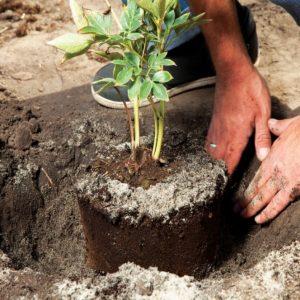
Planting peonies
How to plant peonies
Growing peonies does not require much time or excessive effort from you.
The most important thing is to choose the right site for the peonies, because they will grow on it for many years. The root system in adult plants reaches a depth of 70-90 cm, so transplanting a bush that has reached 4-5 years of age is not an easy task
Peonies prefer to grow in well-lit areas, sunlight for 5-6 hours in the morning is very desirable. But peonies are afraid of drafts, so it would be nice if they were protected by tall bushes or trees.
Do not plant peonies in lowlands: rhizomes can rot from stagnant water.
In the photo: Growing peonies in a flower bed
As for the choice of soil, loam with an acidity of 6-6.6 pH is best suited for peonies. Too clay soil will need to add humus, sand and peat. In sandy - peat, clay and humus. Sand, wood ash and organic matter are added to peat soils.
Planting peonies in autumn
And they plant and transplant peonies in late August - early September.A week before planting the peonies, holes are dug 60x60x60 cm at a distance of 70-100 m from each other, a drainage layer of 20-25 cm from coarse sand, broken brick or crushed stone must be laid on the bottom of the holes. Then a layer of top dressing is poured, consisting of compost, humus, 100 g of lime, 200 g of superphosphate, 100 g of potassium sulfate, 300 g of wood ash - with a layer of 20-30 cm. Then the pits are filled to the top with earth mixed with compost. A week later, by the time the peonies are planted, the soil in the pit will sag, which will make it possible to place the rhizome of the peony in the hole, sprinkle it with garden soil and lightly tamp the soil.
Keep in mind that peonies do not tolerate deep planting: the result will be a dense green bush with no flowers.
If you want to wait for lush flowering peonies, deepen the rhizome so that the upper bud is no deeper than 3-4 cm underground. In addition, in the first year after planting or transplanting, the peonies do not bloom and look lethargic. It so happens that the next year the peonies will not bloom, but it's not scary if the bush looks healthy - it's just that the peony bush has not yet reached maturity.
In the photo: Peony bud
Planting peonies in spring
Actually, peonies are not planted in spring. But it happens that it was in the spring that you got the planting material that you dreamed of ... and what to do? In this case, experts suggest planting peonies in a 2-3-liter pot and keeping them in a cool dark room - a basement or cellar - before planting in the ground, keeping the soil moist. To do this, you need to put snow or pieces of ice on top of the ground, which, having melted, will moisten the soil in the pot. At the end of April or May, the peony is taken out into the garden and buried in the ground directly with the pot, where it will remain until the autumn transplant into a prepared pit, carried out by the transshipment method, that is, together with an earthen lump in which the rhizome was located.
Breeding methods for peonies by dividing the bush and cuttings
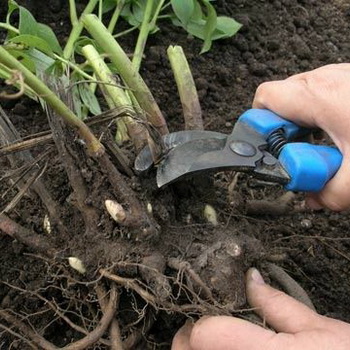 When caring for peonies, reproduction is done in three ways. The easiest is the reproduction of peonies by dividing the bush, in which the rhizome is dug up from mid-August to mid-September, and then divided so that each piece of the rhizome has at least 3 buds. In this case, the old roots are shortened and new plants are planted in a previously prepared place.
When caring for peonies, reproduction is done in three ways. The easiest is the reproduction of peonies by dividing the bush, in which the rhizome is dug up from mid-August to mid-September, and then divided so that each piece of the rhizome has at least 3 buds. In this case, the old roots are shortened and new plants are planted in a previously prepared place.
Using the method of reproduction of peonies by layering, in the spring they put a box without a bottom measuring 50 X 50 cm, 35 cm high on the bush.As the shoots grow, 5 cm soil (humus, peat) is added to the box in layers. The soil in the box must be moist. In the process of development, the peony forms renewal buds and additional roots. From mid-August to mid-September, it is necessary to cut the stems under the new buds and plant them for growing in the nursery.
When peonies are propagated by cuttings, two weeks before the flowering of the bush early in the morning, a cutting of a leaf is cut off near the ground, the cut is made with a sharp knife. Take a stalk from the bottom or middle part. Under the bottom sheet, after 1.5 cm, an oblique cut is made, above the top sheet, an upper cut is also made after 1.5 cm (the top sheet is shortened by 1/3).
No more than 2 cuttings can be cut from one stem. They are placed in water, to which a rooting stimulant is added and left for one day. Then the cuttings are planted in a greenhouse - these are boxes, where the bottom layer is formed by 30 cm of earth and 10 cm of sand. Planted at an inclination of 45 °. In this case, the leaves should not be in contact with each other. The planted cuttings are closed and shaded for the first few days. They are sprayed twice a day for two weeks. After rooting the cuttings, the greenhouse is gradually opened. For the winter, the leaves are cut, covered and the plants are left in a greenhouse.
However, not all varieties of peonies can be rooted in this way.
Hello dear readers!
Peonies are noble and lucky flowers, some of the most attractive in the garden.
No wonder the ancient Greeks were actively engaged in the reproduction of peonies, considering these beautiful centenarians (flowers bloom profusely and magnificently for many decades) as powerful amulets from evil spells, protectors from adversity and misfortune.
The kings of the garden area begin to savor in the last spring month and delight us with their lush flowering until mid-summer.
There is never too much beauty! How to properly propagate exquisite flowers?
Saplings of these wonderful flowers are quite expensive.
Therefore, if we want to plant more bushes of this plant in our garden, let's master the reproduction of peonies ourselves.
The topic of our article today will be the reproduction of peonies in several main ways.
It's time to deal with this interesting and important question.
Reproduction of a tree peony by vegetative methods
There are 4 methods of vegetative propagation of the tree peony.
By dividing the bush, it is applicable for plants aged 5-6 years
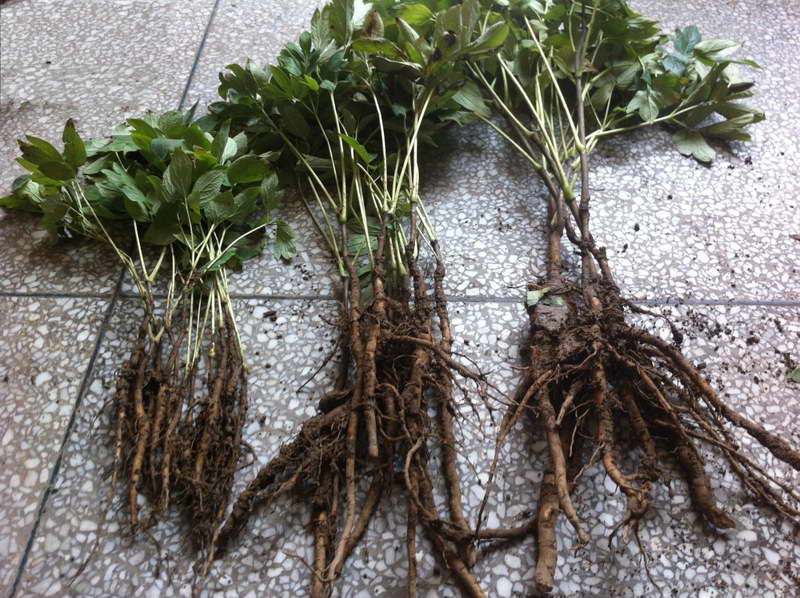
Reproduction of a tree peony by dividing a bush photo
The optimal time for the procedure is late summer and early autumn. Dig up and carefully divide the bush, be sure to treat the cuts with a fungicide. Each section should contain 2-3 growth buds and roots 10-20 cm long.
Reproduction by layering
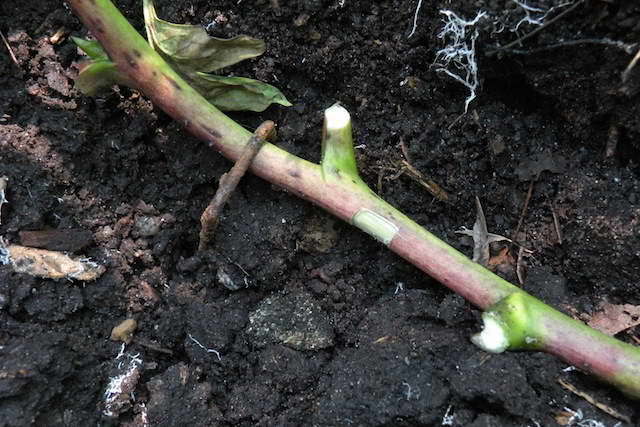
Reproduction of tree peonies by layering photo
Do this before flowering (in May). Bend the developed shoot in the ground, make a shallow longitudinal incision about 10 cm long on the bark, treat it with a growth stimulator. Pin to the ground with a staple, sprinkle with a layer of soil 8-10 cm thick, leaving the top on the surface. Maintain soil moisture, roots will appear by the end of the warm season, but the sprout should be separated from the mother plant at the end of the next summer.
Grafting on the root of a herbaceous peony
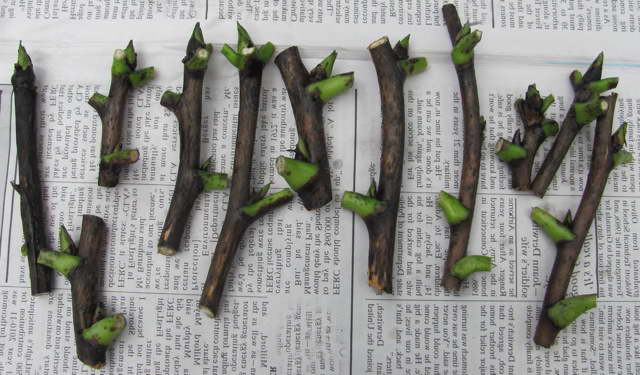
Scion cuttings of a tree peony photo
In the middle lane, this is done in August.
The stock is a part of the root of a herbaceous plant 10-15 cm long. Graft is cuttings cut into semi-lignified shoots of the current year. It is good if the thickness of the rootstock and the scion are the same. The grafting is done with a scion or whipping (with a significantly greater thickness of the scion, only this method is used).
Roots for the rootstock should be dug out 2-3 weeks in advance and stored in a cool place.
Each stalk should have 1-2 buds (cut 2-3 cm above the top, 3-4 cm below the bottom, remove the leaves). Use isopropyl alcohol to sterilize the instrument. You will need a very sharp knife and sharp garden shears.
Grafting
Grafting a tree peony on a herbaceous root how to make
Make a cross-section at the root, and if the diameter of the root is larger than the cutting, you will need a wedge-shaped cut. Cut the stalk on both sides with a wedge (it is advisable to do this under water - this will not clog the porous fabric). Then insert into the incision.
Inoculation of a tree peony on the root of a herbaceous photo
Wrap the top with special tape for grafting (when using ordinary electrical tape, turn the adhesive side out), it is necessary to grab a cross section of the root. Top should be coated with garden varnish.
Vaccination in the butt
How to plant a tree peony on the root of a herbaceous peony
On the root and cutting, make cuts (they should be smooth) at a slight angle, align and fasten in the same way.
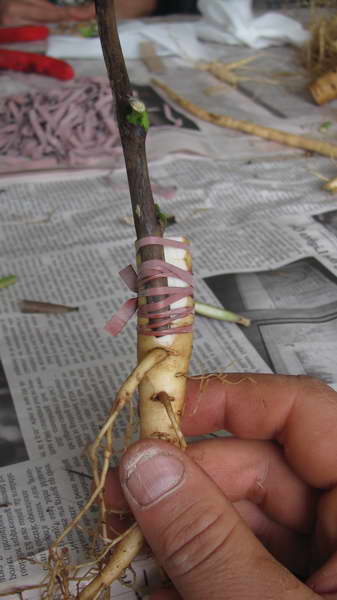
Inoculation of a tree peony in the application photo
What to do with grafted seedlings
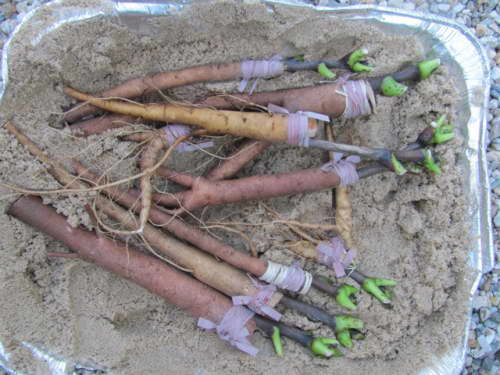
What to do with grafted tree peony seedlings photo
You can plant grafted plants in a greenhouse for 3-4 weeks; when planting, the scion should be above the soil level. Water regularly.
Another (more preferable) method: the grafted material is placed in boxes, shifted with moss or sawdust, covered with plastic bags and kept in the basement for the same time.
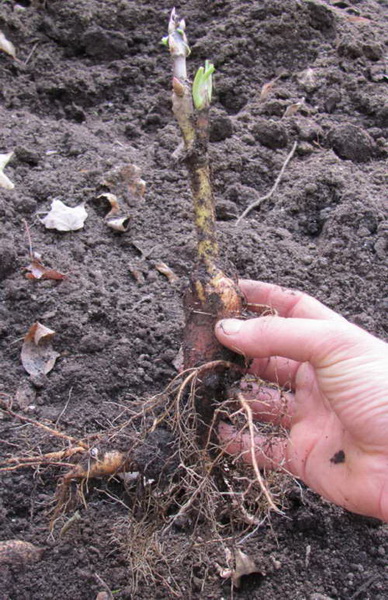
A grafted tree peony ready for planting in a permanent place photo
Successfully grafted plants are transplanted into open ground, placing them at an angle.For the winter, cover with a layer of straw, which must be removed in the spring. The cuttings are grown until autumn, in the fall they are transplanted to a permanent place of growth.

A grafted tree peony seedling in the second year of life photo
Propagation by green cuttings
A fairly effective method (about 60-70% rooted). A significant amount of planting material can be obtained at the same time. Cuttings should be prepared before the lignification process begins (throughout June); it is better to cut them in the morning. Leave 2 buds of growth, make an oblique cut under the bottom (at a distance of 1.5-2.5 cm), above the top - even (distance 2.5-3 cm). Shorten the leaves by 1/2 or 1/3. Treat with growth stimulant.
Plant in a sand-peat mixture at an angle, deepening by 4-5 cm, cover on top with a jar or a cut plastic bottle. Maintain soil moisture, spray the leaves. The first roots will appear in 1.5-2 months. Remove the shelter gradually. For the winter, dig the cuttings in the hole and cover. In the spring, transplant to a test bed for growing - by the fall, an shoot should develop from the lower bud. Then you can transplant to a permanent place of growth, if you wish, postpone the procedure until next season.
Peony transplant
When to transplant peonies
Wild peonies grow in one place for up to fifty years or more. Hybrid varieties that originated from the medicinal peony can grow without transplanting in the same area for no more than ten years, after this period, the bush must be divided and transplanted to another place. In addition, by dividing and planting a bush, the simplest and most reliable way of breeding peonies is carried out. But for this purpose, 4-5-year-old bushes are used, which have already fully bloomed once or twice. The fact is that the root system of peonies grows strongly over the years, so it is easier to cope with a younger rhizome than with an old one, so in order for the quality of flowering of your peonies not to decrease, it will be better to divide and plant the bushes every three to four years ... Peonies are transplanted in September.
In the photo: White peony flower
Transplanting peonies in autumn
How to transplant peonies? In the fall, the bush is dug in at a distance of 25 cm from the rhizome, then carefully loosened with a pitchfork and removed from the ground. The rhizome is cleaned from the soil with a peg, then washed with a not very strong jet of water so as not to damage the fragile buds-eyes of peonies
The ground part is cut almost to the root. The washed rhizome is left in the open air so that the water is glass, and the roots are slightly wilted and become more elastic. Then the old thick roots are pruned to a length of 10-15 cm at an angle of 45 °.
Examine the root carefully and only then proceed to division.
If the bush is old, then it is most convenient to drive a wedge into its middle with a hammer, which will split the rhizome into several parts. Often in the middle of old rhizomes there are voids and rotten areas that need to be cleaned out, disinfected with a strong solution of potassium permanganate, and then powdered with fungicide. Delenki should consist of a part of the root collar with well-developed 3-4 eyes and several roots. It is necessary to try to divide the rhizome into approximately equal parts, so that there are neither too large divisions that will hurt for a long time after transplantation, nor too small ones that may die.
In the photo: Growing peonies in the garden
How to transplant peonies
It is necessary to plant the cuttings in the ground in the way that has already been described. The area with transplanted plants for the winter must be mulched with a seven-centimeter layer of peat, you can remove the mulch when in the spring reddish peony sprouts break through it. In the first two years after transplanting, peonies should build up a root system, so be patient and do not let young plants bloom. In the first year, pinch off all the buds that appear, the next - leave only one bud on the bush and, when it bursts, cut it as short as possible and consider how the flower matches its variety.If the match is incomplete, then you will have to pinch off the buds for another year, leaving only one until the flower fully matches its variety. This can happen in the third year, and maybe in the fifth.
Peony care
Peony care in autumn
In the fall, as already mentioned, it is time to plant and transplant peonies. Peonies are not planted every year, and if in the current year you have no plans to breed them, caring for peonies in the fall comes down to pruning withered stems and leaves, which then need to be burned to destroy viruses, bacteria and pests that may , settled in them. The remains of the stems on the bushes should be sprinkled with ash at the rate of 2-3 handfuls per bush. That's all there is to do in the fall. Now we will tell you how to care for peonies in the spring.
In the photo: Blooming pink and white peonies
Peony care in spring
Watering peonies requires infrequent, but plentiful - 2-3 buckets for each adult bush so that the soil gets wet to the depth of the roots. Plants especially need moisture in early spring, during the growth period, as well as during the budding and flowering period and in August-September, when new buds are laid in the peonies. After watering, it is imperative to loosen the soil around the bushes and remove weeds, if any. Make sure that when watering, the water gets under the bush, and not on the leaves.
Feeding peonies
As soon as the snow melts, the ground around the bushes is watered with a solution of potassium permanganate at the rate of 2-3 g per 10 liters of water for two peony bushes. When the shoots begin to grow, you need to feed the plants with ammonium nitrate at the rate of 15 g of nitrate per 10 liters of water. Starting from the second week of May, young plants are watered once a month over the leaves from a watering can with a sieve with a solution of complete mineral fertilizer in the recommended concentration. Add washing powder to the solution at the rate of 1 tablespoon per 10 liters of water - this will prevent the solution from simply flowing down the leaves into the ground. Top dressing is carried out in the evening or on a cloudy day.
How to grow a hydrangea from a cutting - instructions
During the period of budding and flowering, it is necessary to mineralize the soil with such a solution: 10 g of superphosphate, 7.5 g of ammonium nitrate, 5 g of potassium salt per 10 liters of water. Two weeks after the end of flowering, you need to feed the peonies with a solution of 10 g of superphosphate and 5 g of potassium salt per 10 liters of water. You can alternate mineral fertilizers with organic ones, and instead of a solution, sprinkle dry fertilizers along the groove around the bush, followed by moistening and embedding in the soil.
In the photo: An expanding peony bud
Caring for peonies in the summer, after the peonies have faded, consists in timely watering, feeding after flowering, weeding and loosening the site.
Pruning peonies
When to prune peonies? Full pruning of peony stems is done in late autumn, when frost sets in. But if it becomes necessary to do this earlier, then try to cut the stems not too low, leaving shoots with three or four leaves above the ground. The fact is that at the end of summer, peonies lay replacement buds, and the success of this process directly depends on the presence of leaves on the bush. Therefore, by the way, when cutting flowers, this rule must be observed: cut the peduncle not very close to the root, leave a part of the stem with several leaves on the bush.
